北の大地の新常識 北海道で叶えるさつまいも自給自足スローライフ
Potager
畑から食卓へ一直線:さつまいもが繋ぐ、スローなオーガニックライフ
#オーガニック #無農薬 #自給自足 #スローライフ #家庭菜園 #Potager
#Hervest #さつまいも #Sweetpotato
Harvesting
- さつまいもの収穫【Harvesting Sweet potato】
- さつまいも について about Sweet Potato
- さつまいもの種類 (Types of Sweet potato)
- さつまいもの基本的な育て方
- 野菜苗植え付け(サツマイモ)
- さつまいもの代表的な料理
- Homemade dish
- まとめ
- YouTube
- Note
- 【スローライフ】オーガニック野菜で農産物の加工
- トマトソースづくり
- 【家庭菜園】Potager&Hervest (Organic)
- オーガニック栽培(無農薬栽培)の現実
- 【スローライフ】 まとめ
- 家庭菜園メリット
- ハロウィンかぼちゃ
- 収穫はこれがあると便利!
- フレッシュトマトジュース作りにはこれが便利(我が家も利用)Kuvings クビンス
- 家庭菜園(ガーデニング)
- おすすめ本
- 北の大地十勝(北海道)に移住
さつまいもの収穫【Harvesting Sweet potato】
さつまいもの収穫
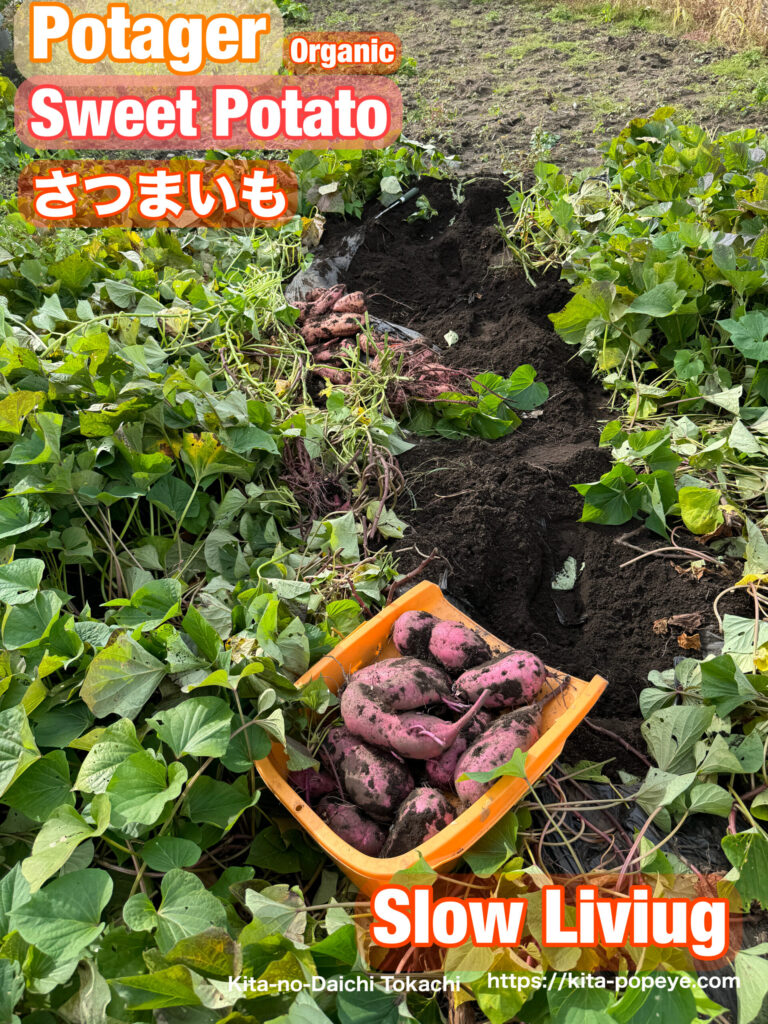
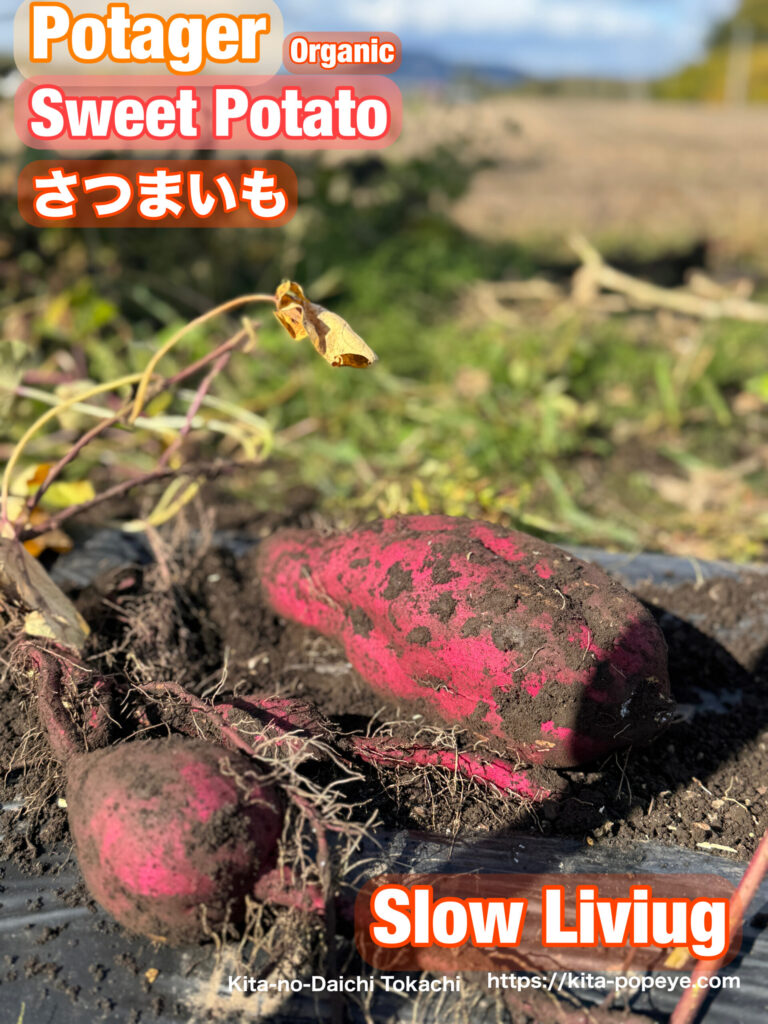
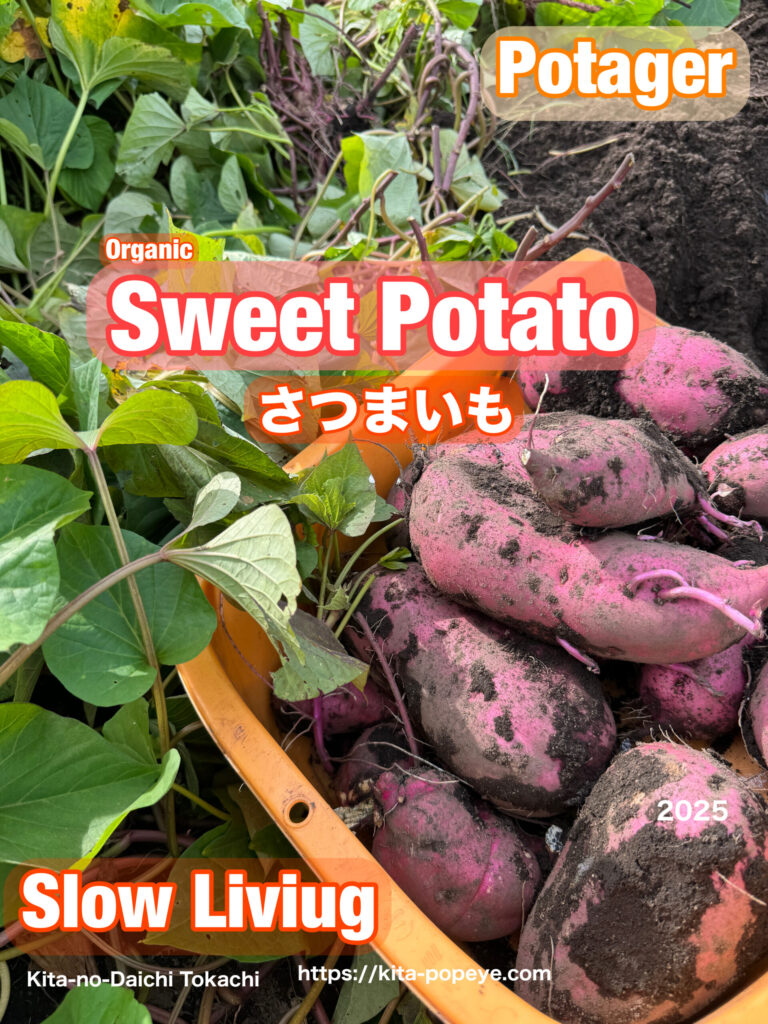
さつまいも について about Sweet Potato
さつまいも(日本語)
• 概要と分類
• さつまいも(薩摩芋、学名: Ipomoea batatas)は、ヒルガオ科サツマイモ属のつる性の多年生植物です。
• 食用とする部分は、養分を蓄えて肥大した塊根(こん)であり、ジャガイモのような塊茎(茎が肥大したもの)とは異なります。
• 別名で「甘藷(かんしょ)」や「唐芋(からいも)」とも呼ばれます。
• 原産地はメキシコを中心とする中南米の熱帯アメリカです。
• 特徴と栽培
• 高温や乾燥に強く、痩せた土地でも育つ丈夫な作物です。この強靭さから、かつては救荒作物(きゅうこうさくもつ)としても重要でした。
• 日本へは1600年頃に中国から琉球(沖縄)を経て薩摩(鹿児島)に伝わり、その名前の由来となりました。
• 収穫後、2〜3ヶ月ほど貯蔵することでデンプンがショ糖に変わり、甘みが増して美味しくなります(糖化)。
• 品種と利用
• 品種は60種類以上あり、大きく分けてホクホク系(鳴門金時、紅あずまなど)、しっとり系、ねっとり系(安納芋、紅はるかなど)があります。
• 果肉の色は白、黄、オレンジ、紫など様々で、紫色はアントシアニン、オレンジ色は**\betaカロテン**を多く含みます。
• 食用として、焼き芋、天ぷら、煮物、菓子などに利用されるほか、焼酎の原料や飼料、デンプンの加工用にも使われます。
• 栄養
• 食物繊維が豊富で、便通改善に役立ちます。
• 切った時に出る白い液体は「ヤラピン」という成分で、これも腸の働きを整える作用があります。
• ビタミンCやビタミンEなども含まれており、特にオレンジ色の品種は$\beta$カロテンが豊富です。
Sweet Potato (English)
• Overview and Classification
• The sweet potato (scientific name: Ipomoea batatas) is a vine-like perennial plant belonging to the morning glory family (Convolvulaceae).
• The edible part is the enlarged storage root (tuberous root), which distinguishes it from the common potato, which is a stem tuber.
• It is native to tropical America, centered in Mexico.
• Despite its name, it is not related to the common potato (Solanum tuberosum) or true yams (Dioscorea species).
• Characteristics and Cultivation
• It is a very hardy crop, highly tolerant of high temperatures and drought, and can grow well even in poor soil. For this reason, it has historically been an important famine food.
• In Japan, it is called “Satsumaimo” because it was introduced around 1600 from China via Ryukyu (Okinawa) and then spread through Satsuma (Kagoshima).
• Sweetness increases after harvest when it is stored for about 2 to 3 months, as the starch slowly converts to sucrose (sugar).
• Varieties and Uses
• There are over 60 varieties, broadly categorized by texture into fluffy/starchy (e.g., Narutokintoki, Beni Azuma), moist, and creamy/sticky (e.g., Annou Imo, Beni Haruka) types.
• Flesh color varies from white, yellow, and orange to deep purple. Purple varieties are rich in anthocyanins, and orange varieties are a significant source of beta-carotene.
• It is consumed in many ways, such as baked, fried (tempura), boiled, and in sweets. It is also used in the production of shochu (Japanese distilled spirit), animal feed, and for starch processing.
• Nutrition
• It is an excellent source of dietary fiber, which aids in bowel regularity.
• The white, sticky liquid that appears when cutting a raw sweet potato is called “Yalapin” (in Japanese), a compound that also helps regulate the digestive system.
• It also contains Vitamin C and Vitamin E. Orange-fleshed varieties, in particular, provide high levels of pro-vitamin A (beta-carotene).
さつまいもの種類 (Types of Sweet potato)
さつまいもは、その食感と甘さによって大きく種類が分けられます。ここでは、代表的な種類を食感タイプ別に日本語と英語でご紹介します。
さつまいもの種類(日本語)
日本のさつまいもは、主にホクホク系、しっとり系、ねっとり系の3つの食感に分類されます。
1. ホクホク系(Fluffy / Starchy Type)
• 特徴: 昔ながらのさつまいもの食感で、加熱すると水分が少なく粉を吹いたようになり、栗のような風味と素朴な甘さが特徴です。
• 代表的な品種:
• 鳴門金時(なるときんとき): 徳島県産。栗のようにホクホクした食感と上品な甘さで、煮物や天ぷらなど万能に使えます。
• 紅あずま(べにあずま): 関東地方で広く栽培。ホクホク感と適度な甘さを併せ持ち、繊維質が少ないため食べやすい品種です。
• 紅さつま(べにさつま): 鹿児島県産。鳴門金時に似た、ホクホクとした食感と濃い黄色い果肉が特徴です。
2. ねっとり系(Creamy / Sticky Type)
• 特徴: 加熱すると水分が多く、濃厚な甘みとねっとりとしたクリームのような食感になるのが特徴です。焼き芋にすると蜜があふれます。
• 代表的な品種:
• 安納芋(あんのういも): 鹿児島県種子島が有名。ショ糖が多く、非常に強い甘みと、ねっとりとしたクリーミーな食感が魅力です。
• 紅はるか(べにはるか): 近年人気の品種。従来のさつまいもより「はるかに」美味しいという意味で名付けられ、ねっとりとした滑らかな食感と強い甘さが特徴です。
3. しっとり系(Moist / Smooth Type)
• 特徴: ホクホク系とねっとり系の中間。絹(シルク)のような滑らかでしっとりとした舌触りが特徴で、上品な甘さがあります。
• 代表的な品種:
• シルクスイート: 絹のように滑らかな舌触りが特徴の新しい品種。加熱するとしっとりとして、高い糖度になります。
• 高系14号(こうけい14ごう): 多くの品種の元となった系統で、しっとりとした食感とバランスの取れた甘さが特徴です。
Types of Sweet Potatoes (English)
Sweet potato varieties in Japan are generally categorized into three main texture types: Fluffy/Starchy, Creamy/Sticky, and Moist/Smooth.
1. Fluffy / Starchy Type (Hoku-Hoku Kei)
• Characteristics: The traditional sweet potato texture. They have a dry, starchy flesh that becomes crumbly or “fluffy” when cooked, with a chestnut-like flavor and simple, rustic sweetness.
• Representative Varieties:
• Naruto Kintoki: Grown in Tokushima Prefecture. Known for its fluffy, chestnut-like texture and refined sweetness, excellent for boiling, tempura, and other uses.
• Beni Azuma: Widely grown in the Kanto region. It offers a balance of fluffiness and sweetness, with a low fiber content making it easy to eat.
• Beni Satsuma: From Kagoshima Prefecture. Similar to Naruto Kintoki, with a fluffy texture and deep yellow flesh.
2. Creamy / Sticky Type (Nettori Kei)
• Characteristics: When heated, these varieties have a high moisture content, developing a rich sweetness and a sticky, creamy, and almost “melting” texture. They tend to ooze syrup when roasted.
• Representative Varieties:
• Annou Imo (or Anno Beni): Famous from Tanegashima, Kagoshima. It is known for its high sucrose content, resulting in intense sweetness and a creamy, sticky texture.
• Beni Haruka: A very popular newer variety. Its name implies it is “far superior” (Haruka) to older varieties. It has a sticky, smooth texture and pronounced sweetness.
3. Moist / Smooth Type (Shittori Kei)
• Characteristics: A middle ground between fluffy and creamy. These potatoes are known for their very smooth, “silky” texture and moderate, elegant sweetness.
• Representative Varieties:
• Silk Sweet (Shiruku Suito): A relatively new variety known for its silky-smooth mouthfeel. It becomes moist and has a high sugar content when baked.
• Kokei 14-go: A base variety for many other cultivars. Features a moist texture and a balanced sweetness.
Note on International Varieties:
In Western markets (especially the US), sweet potatoes are often grouped by flesh color and moisture content:
• Orange-Fleshed (Moist): e.g., Beauregard or Jewel. These are very sweet and moist, often mistakenly called “yams” and used for mashing, baking, and pies.
• Yellow/White-Fleshed (Dry/Starchy): e.g., Hannah or O’Henry. These are starchier and drier, with a milder, less sweet flavor, similar to the texture of a traditional potato.
• Purple-Fleshed: e.g., Okinawa Sweet Potato (Beni Imo) or Purple Stokes. These have vibrant purple flesh rich in anthocyanins and typically have a denser, sometimes drier, texture.
さつまいもの基本的な育て方
さつまいもの基本的な育て方について、日本語と英語で説明します。
さつまいもの基本的な育て方(日本語)
• 1. 植え付け時期と準備
• 時期: 晩霜の心配がなくなり、地温が18℃以上になる5月下旬から6月上旬頃が適期です(地域による)。
• 土壌: 日当たりと水はけの良い場所を選びます。痩せ地を好み、肥料(特に窒素分)が多すぎると「つるぼけ」(葉や茎ばかりが茂り、芋ができない状態)になるため、多くの場合は無肥料または控えめにします。
• 畝(うね)立てとマルチング: 水はけを良くするため、高めの畝を立てます。黒マルチ(ビニールシート)をかけると地温が上がり、雑草防止にも効果的です。
• 2. 苗(さし苗)の植え付け
• 苗: さつまいもは種ではなく、専用の「さし苗」(つる)を植えます。園芸店で購入するか、市販の芋から自分で育てることもできます。
• 植え方: 苗の節から根が出て芋になるため、3〜4節を土に埋めるように植え付けます。一般的なのは、苗を畝に沿って寝かせる「水平植え」や、斜めに植える「斜め植え」です。先端の生長点は土に埋めないようにします。
• 水やり: 植え付け直後は、根付く(活着する)までたっぷり水を与えます。
• 3. 栽培管理
• 除草: 植え付け後1ヶ月ほどはつるの生育が遅いため、こまめに除草します。つるが地面を覆えば雑草は生えにくくなります。
• つる返し: 伸びたツルが地面に接すると、その節からも根が出て小さな芋ができ、本来の芋に養分が分散してしまいます。これを防ぐため、伸びたつるをときどき持ち上げてひっくり返す「つる返し」を行います。
• 4. 収穫
• 時期: 植え付けから約120日(4ヶ月)が目安です。葉が黄色くなり始めたら収穫のサインです。
• 方法: 収穫の前に、伸びたつるを鎌などで刈り取ります。株の周りをスコップや鍬で丁寧に掘り起こし、芋を傷つけないように取り出します。
• 追熟(貯蔵): 掘り上げた芋は、泥を軽く落とし、13~15℃の暗く乾燥した場所で数週間貯蔵すると、デンプンが糖に変わり甘みが増します(キュアリング・貯蔵)。
Basic Sweet Potato Growing Guide (English)
• 1. Planting Time and Preparation
• Timing: The ideal time to plant is in late May to early June (depending on the region), after the danger of the last frost has passed and the soil temperature is consistently above 18℃. Sweet potatoes love heat.
• Soil: Choose a sunny spot with well-draining, loose, and sandy soil. They prefer less fertile soil; too much fertilizer, especially nitrogen, causes “vine growth” (lush leaves but few or small roots), so generally, use no fertilizer or very little.
• Mounding and Mulching: Create high mounds or raised beds for good drainage. Using black plastic mulch helps warm the soil and suppresses weeds.
• 2. Planting Slips
• Slips: Sweet potatoes are grown not from seed, but from vine cuttings called “slips.” You can buy them or grow your own from a store-bought sweet potato.
• Planting Method: The root nodes (joints) on the slip will develop into tubers, so plant the slip so that 3 to 4 nodes are buried in the soil. The two most common methods are “horizontal planting” (laying the slip flat along the ridge) or “slant planting.” Ensure the growth tip (the very end of the vine) is not buried.
• Watering: Water thoroughly right after planting until the slips are established.
• 3. Cultivation Management
• Weeding: Weed regularly for the first month, as vine growth is slow initially. Once the vines cover the ground, they will suppress most weeds.
• Vine Turning (Tsuru-gaeshi): When the long vines touch the soil, they can sprout roots at the nodes and form small, unproductive tubers, which steals energy from the main crop. To prevent this, occasionally lift and flip the vines—this is called “vine turning.”
• 4. Harvest
• Timing: Sweet potatoes are typically ready for harvest about 120 days (4 months) after planting, often when the leaves start to yellow.
• Method: Cut back the long vines before harvesting. Carefully dig around the plant with a shovel or spade to avoid damaging the tubers, then gently lift them out.
• Curing and Storage: Do not wash the harvested potatoes; simply brush off the excess dirt. Cure them in a warm, dark, and humid place (around 13\text{℃} \sim 15\text{℃} or 55\text{°F} \sim 60\text{°F}) for a few weeks. This process converts starch to sugar, making them sweeter, and also helps heal any skin damage, improving their storage life. Do not store them in the refrigerator, as they are sensitive to cold.
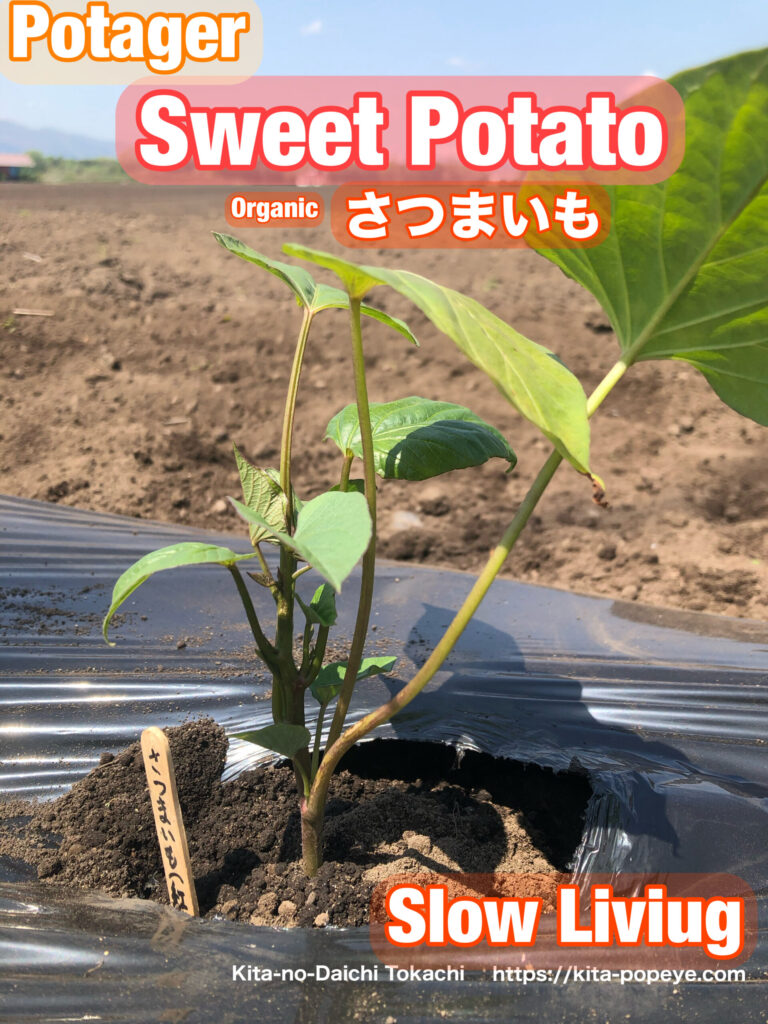
野菜苗植え付け(サツマイモ)
【2025】
さつまいも:パープルスイートロード(つる取り用)328・あまはずき4p598パワーコメリ5/26
シルクスイート特140x2工藤公園5/31
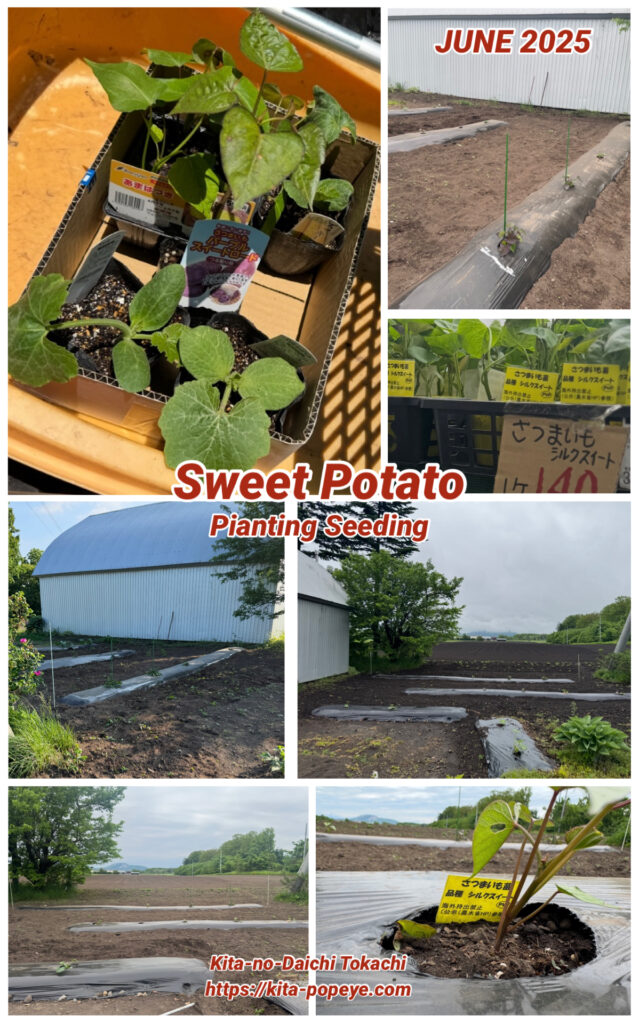
さつまいもの代表的な料理
さつまいもは、日本でも海外でも甘さを活かしたスイーツや、おかずとして幅広く楽しまれています。
さつまいもの代表的な料理(日本語)
1. 和風の定番
• 焼き芋(やきいも):
• 英語名: Roasted Sweet Potato (Yaki Imo)
• 説明: 石焼きやオーブンでじっくりと時間をかけて加熱し、さつまいもの甘みを最大限に引き出した、日本の秋から冬にかけての代表的なおやつです。
• 大学芋(だいがくいも):
• 英語名: Candied Sweet Potatoes (Daigaku Imo)
• 説明: 乱切りにしたさつまいもを揚げてから、醤油や砂糖などで作った甘いタレ(蜜)を絡ませ、仕上げにごまを振った料理です。外はカリッと、中はホクホクした食感が特徴です。
• スイートポテト:
• 英語名: Sweet Potato Cake (Japanese Style)
• 説明: 蒸したり焼いたりしたさつまいもを潰して、バター、砂糖、牛乳などと混ぜて成形し、表面に卵黄を塗って焼いた洋風の和菓子です。
• さつまいもご飯(さつまいもごはん):
• 英語名: Sweet Potato Rice (Satsuma Imo Gohan)
• 説明: 米と一緒に角切りにしたさつまいもを炊き込み、塩や少量の調味料で味付けしたご飯です。さつまいもの自然な甘さが楽しめます。
• 芋ようかん(いもようかん):
• 英語名: Sweet Potato Jelly (Imo Yokan)
• 説明: 蒸したさつまいもを潰し、砂糖と少量の塩を加えて固めた、シンプルな和菓子です。
2. おかず・調理用
• 天ぷら(てんぷら):
• 英語名: Sweet Potato Tempura
• 説明: 薄切りにしたさつまいもを衣で包み、油で揚げたものです。サクサクとした衣と、さつまいもの甘さがよく合います。
• きんぴら(きんぴら):
• 英語名: Kinpira-style Braised Sweet Potato
• 説明: ささがきまたは細切りにしたさつまいもを炒め、醤油や砂糖、みりんなどで甘辛く味付けした和え物です。
Famous Sweet Potato Dishes (English)
1. Japanese Classics
• Yaki Imo (Roasted Sweet Potato):
• Japanese Name: 焼き芋
• Description: A quintessential Japanese snack, especially popular in autumn and winter. The sweet potatoes are slowly roasted, often over hot stones (ishi-yaki imo), to maximize their natural sweetness. They are eaten piping hot with the skin on.
• Daigaku Imo (Candied Sweet Potatoes):
• Japanese Name: 大学芋
• Description: Deep-fried chunks of sweet potato coated in a thick, sweet glaze (made with sugar and often soy sauce) and sprinkled with black sesame seeds. The name, meaning “University Potato,” is said to come from the early 1900s when it was sold to students.
• Sweet Potato (Japanese Style Dessert):
• Japanese Name: スイートポテト
• Description: A popular baked confection where mashed and seasoned sweet potato (with butter, sugar, and milk/cream) is shaped into an oval or a potato-like form, brushed with egg yolk, and baked.
• Satsuma Imo Gohan (Sweet Potato Rice):
• Japanese Name: さつまいもご飯
• Description: A simple dish of white rice cooked together with diced sweet potatoes and seasoned lightly with salt or soy sauce, celebrating the potato’s mild, natural sweetness.
2. Other Popular Preparations
• Sweet Potato Tempura:
• Japanese Name: さつまいもの天ぷら
• Description: Sweet potato slices are coated in a light batter and deep-fried until crispy. The hot, tender sweetness of the potato contrasts beautifully with the crispy tempura batter.
• Sweet Potato Pie (American Style):
• Japanese Name: 芋パイ
• Description: A staple dessert in American cuisine, particularly during the holidays. It consists of a pie crust filled with a creamy custard made from mashed orange-fleshed sweet potatoes, eggs, milk, sugar, and spices (like cinnamon and nutmeg).
• Sweet Potato Fries:
• Japanese Name: さつまいものフライドポテト
• Description: Sweet potato cut into strips and deep-fried, often served with a savory seasoning or a sweet dipping sauce.
• Sweet Potato Mash (or Casserole):
• Japanese Name: マッシュポテト(さつまいも)
• Description: Mashed sweet potatoes, often mixed with butter, brown sugar, or marshmallows (in the casserole form), and served as a side dish in Western meals.
Homemade dish
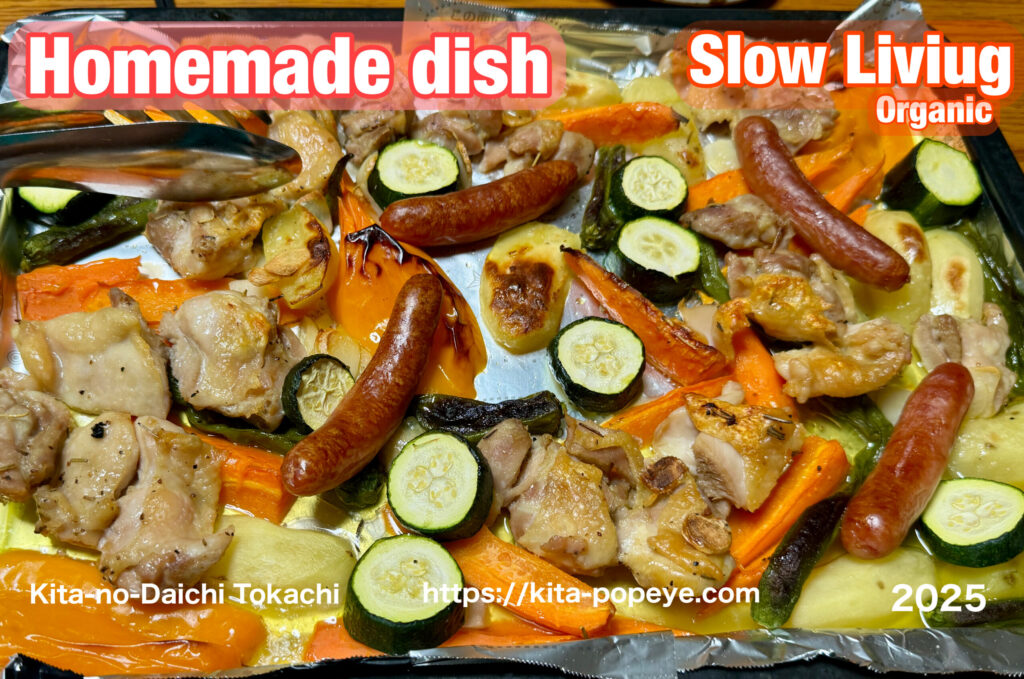
Homemade dish
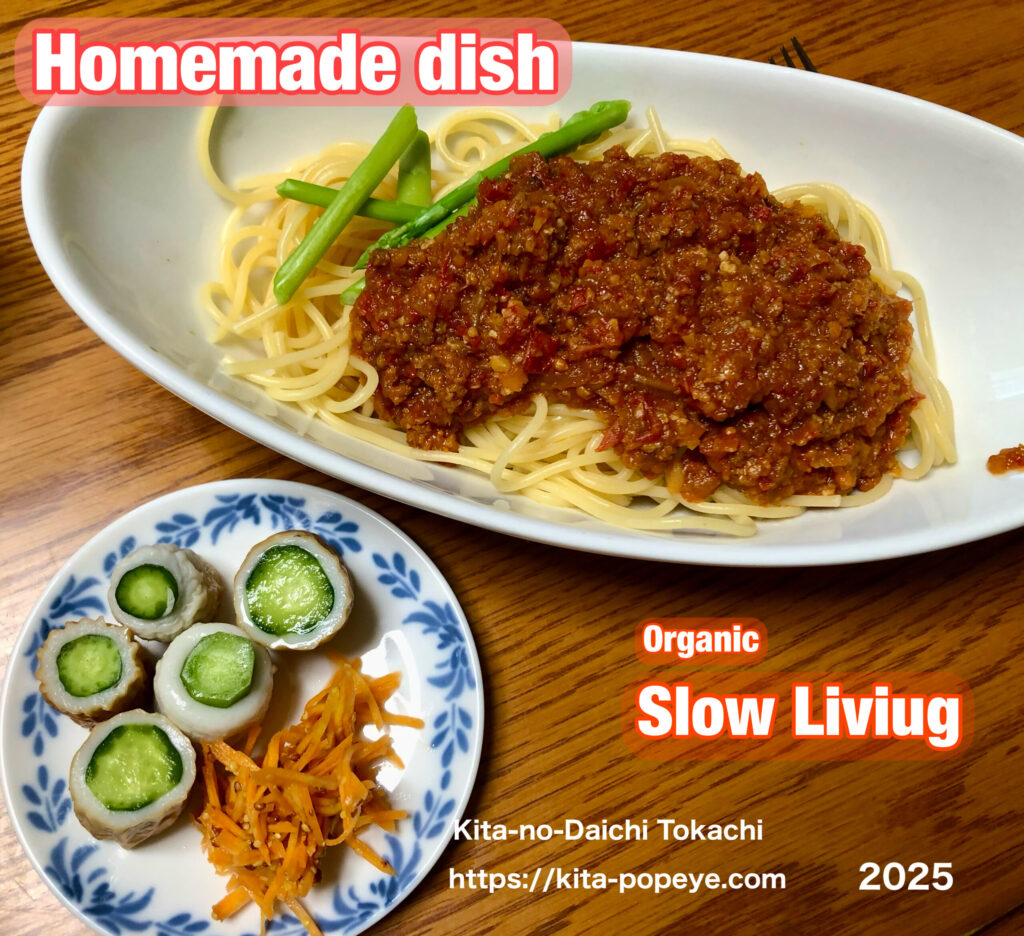
野菜ジュース
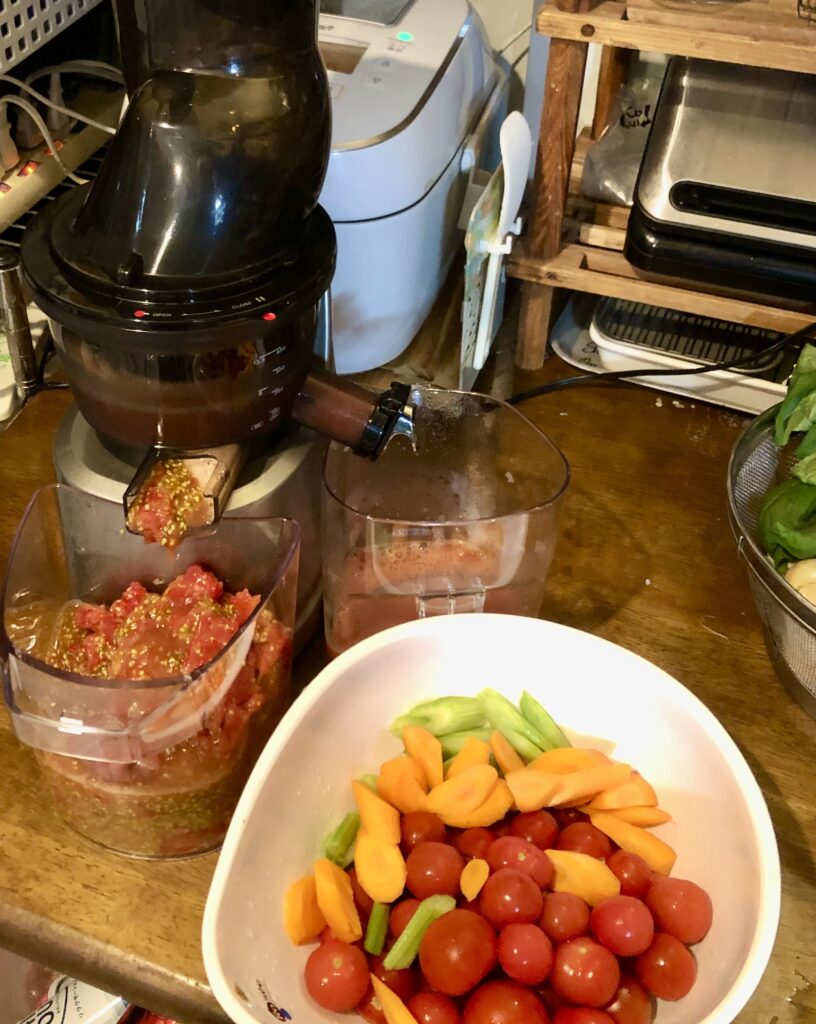
まとめ
• 北の大地、北海道というかつては不可能とされた地で、私は今、さつまいもを中心としたオーガニックな自給自足生活を送っています。
• 昔から「いも」といえばじゃがいもの土地でしたが、温暖化という時代の変化を受け、今では路地栽培で豊かにさつまいもが実ります。
• 温暖化への懸念は持ちつつも、この恵みを食料自給の糧とし、焼き芋、スイートポテト、保存食など、多様な料理や加工品に変えるスローライフを楽しんでいます。
この一連の循環は、自然のリズムに合わせた心地よい暮らし(スローライフ)と、安心安全な食べ物を自分で生み出すオーガニックな生き方そのものを体現しています。
On the vast northern land of Hokkaido, I am pursuing an organic slow life, aiming for self-sufficiency by cultivating sweet potatoes and transforming them into a variety of dishes and preserved foods.
• Historically, sweet potato cultivation was unsuitable here (it was potato country!), but due to climate change, we can now grow them successfully outdoors. While mindful of the warming trend, I embrace this bounty for food self-sufficiency and enjoy every step of the process.
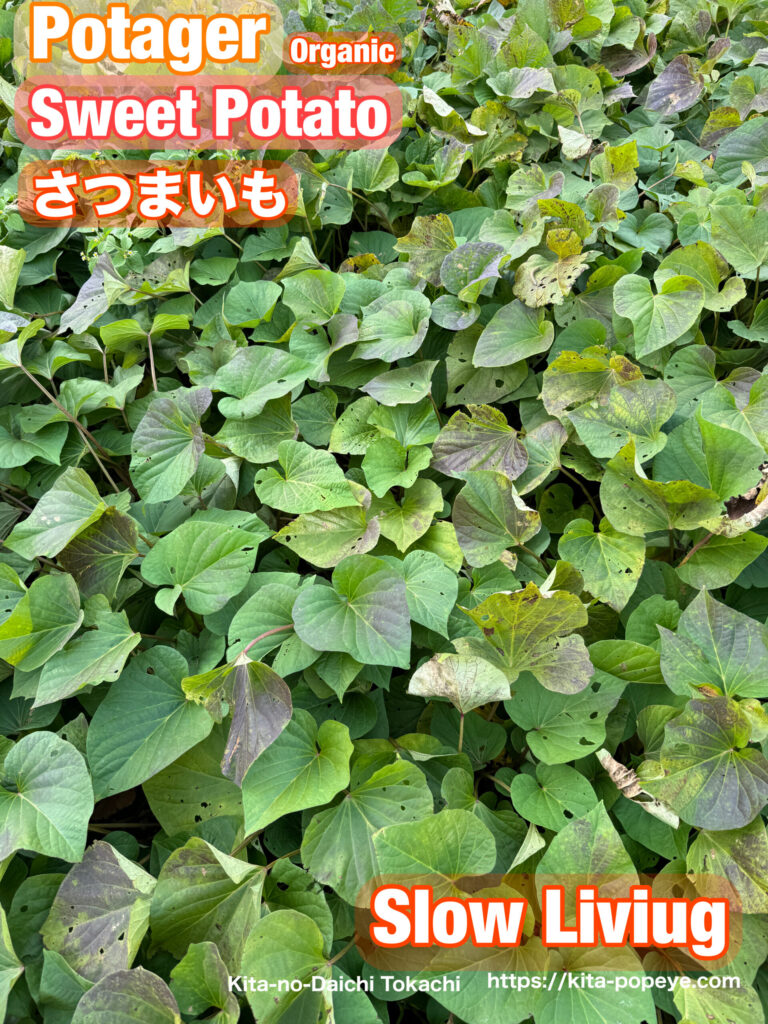
YouTube
Note
【スローライフ】オーガニック野菜で農産物の加工
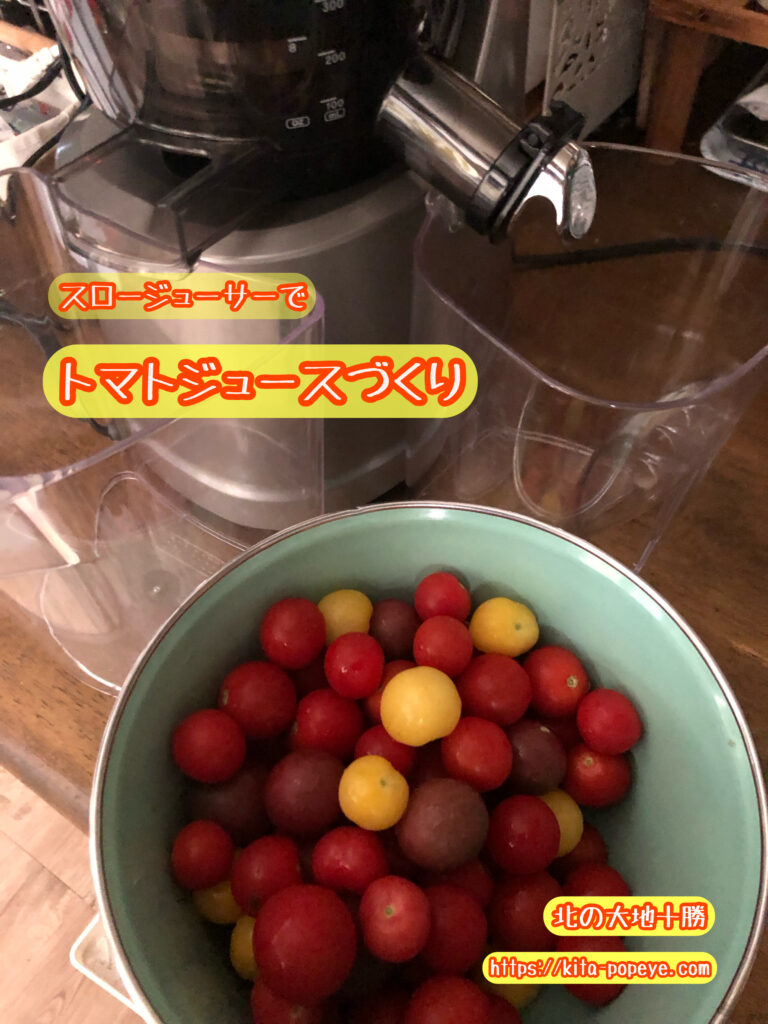

Kuvings クビンスのスロージューサーを使用
興味のある方は下記のバーナーもしくはブログの下部に案内があります。
トマトソースづくり
トマトジュースで出た搾りかすも無駄なくソースづくりに利用
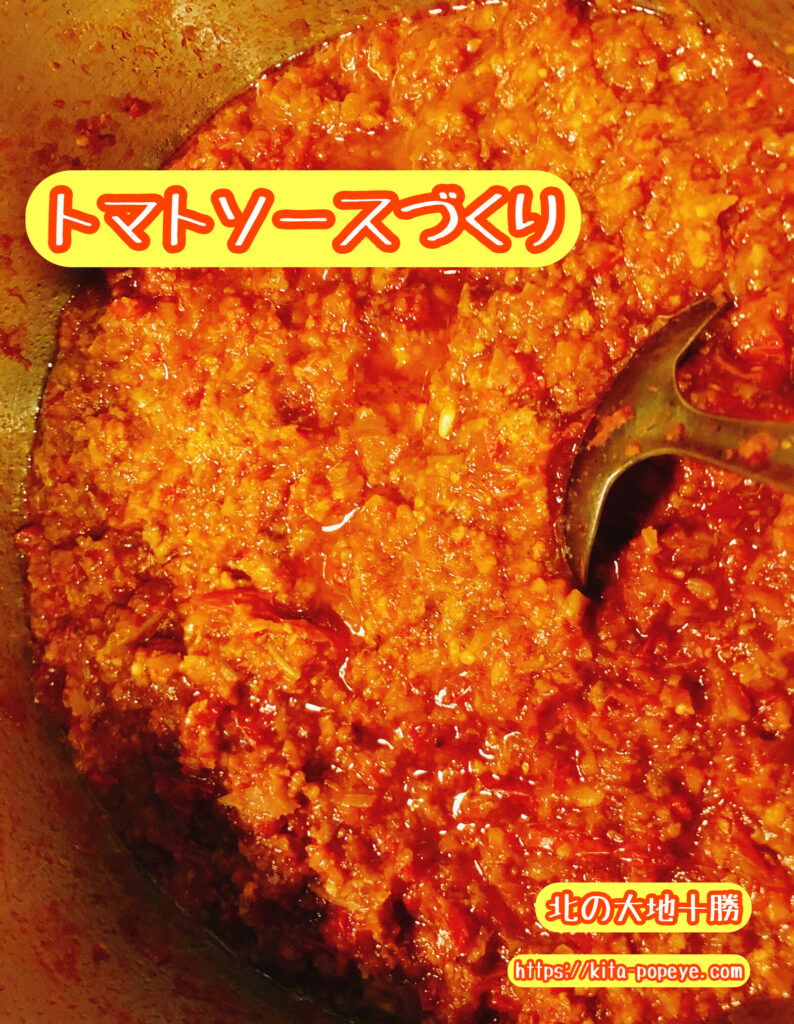
トマトソースの作り方。簡単な手順です。
材料:
- 新鮮なトマト(今回は自家製)もしくはトマト缶
- ニンジン
- 玉ねぎ
- オリーブオイル
- 塩とこしょう
- ガーリック(お好みで)
- バジルやオレガノなどのハーブ(お好みで)
手順:
- 玉ねぎとガーリックをみじん切りにし、鍋にオリーブオイルを熱して炒めます。
- 玉ねぎが透明になるまで炒めたら、トマト缶を加えます。新鮮なトマトを使用する場合は、皮をむいて刻んで加えます。
- 中火でトマトを煮詰め、水分が少なくなるまで煮ます。途中で塩やこしょう、ハーブを加えて調味します。
- トマトが柔らかくなったら、ソースを滑らかにするためにブレンダーやフードプロセッサーで混ぜます。粗熱を取りながら行ってください。
これでできあがりです。パスタやピザ、その他の料理に使ってお楽しみください!
【家庭菜園】Potager&Hervest (Organic)

オーガニック栽培(無農薬栽培)の現実
少しサボってしまうと、このようになり、栽培はなかなか難しくですが、安全安心な野菜を目指して頑張ります。
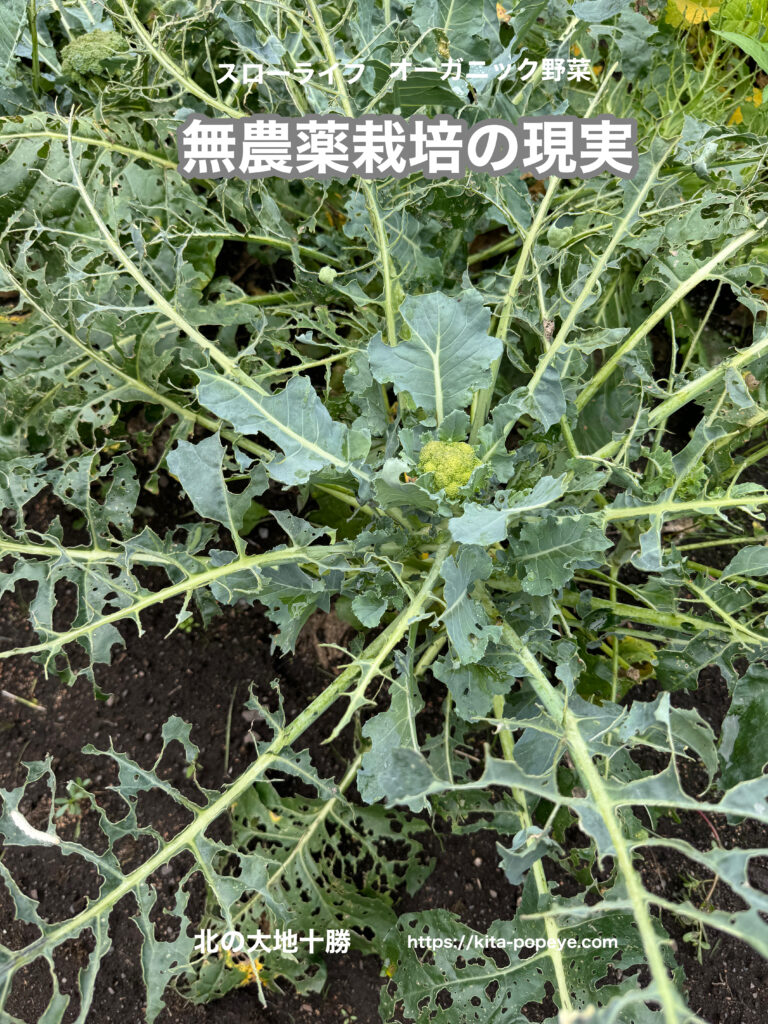
蝶々(ちょうちょう)がいっぱい飛んでいて、アオムシくんがいっぱい!
【スローライフ】 まとめ
家庭菜園で育て収穫した新鮮なトマトは、豊かな味と香りを持っています。その美味しさを存分に活かし、さまざまな料理に楽しみの表現を加えることができます。
- フレッシュなトマトサラダ: 太陽の光をたっぷり浴びて育ったトマトを使ったサラダは、鮮やかな赤色と甘みが特徴です。一口食べると、夏の恵みを感じることができるでしょう。新鮮なバジルとオリーブオイルを加えて、さわやかな香りと滑らかな食感を楽しみましょう。
- トマトとモッツァレラのカプレーゼ: トマトとモッツァレラのシンプルな組み合わせは、イタリアの伝統的な料理です。トマトの酸味とモッツァレラのクリーミーな味わいが絶妙に調和し、食卓に彩りと美味しさを添えます。
- トマトケチャップ: 収穫したトマトをトマトケチャップに加工すると、バーガーやフライドポテトを楽しむ時に大活躍です。自家製のトマトケチャップは、市販品にはない深い味わいと自然な甘みがあり、子供から大人までみんなに愛されることでしょう。
- トマトペースト: トマトペーストは、トマトの濃厚な味わいを凝縮させた贅沢な調味料です。パスタソースやピザのトッピングに使えば、家庭料理が本格的なイタリアンに変身します。トマトの旨味が一層際立ち、食欲をそそります。
- トマトカレー: トマトの酸味がカレーに絶妙なアクセントを加えます。甘みと酸味のバランスが取れたトマトカレーは、辛さを抑えつつ奥深い味わいを楽しめます。ご飯との相性も抜群です。
- グリル野菜のトマトソース添え: トマトソースを添えたグリル野菜は、ヘルシーで美味しい一品として楽しめます。トマトのさわやかな風味が、野菜たちの旨味を引き立てます。
- トマトスープ: 新鮮なトマトを使ったホームメイドのトマトスープは、体を温める冬の一品として最適です。ほっこりとした優しい味わいが、心と体を癒してくれます。
家庭菜園で育てたトマトをこれらの料理に活用すると、旬の味と素材の豊かさを存分に味わうことができます。手間暇かけた自家製の料理は、家族や友人との食卓を特別なひとときにしてくれるでしょう。楽しさが広がるトマトの恵みを、心を込めて料理に表現してみてください。

各花、果実、野菜などの特徴と育て方の説明を『チャットGTP』にヘルプして頂き作成しました。参考になればと思います。
家庭菜園メリット
- 収穫の喜び:自分で育てた野菜や果物などを収穫する瞬間は、とても嬉しいものです。手間暇かけて育てたからこそ、その味わいも格別で、料理に使う時も一層美味しく感じます。
- 自給自足の達成感:自分で育てた果物や野菜などを食べることで、自給自足の達成感を味わうことができます。自分で栽培した食材を食べることで、より健康的な生活を送ることができるだけでなく、環境にも貢献することができます。
- 自然とのつながりを感じる:家庭菜園で育てることで、自然とのつながりを感じることができます。種をまき、水をやり、土を肥やし、成長を見守ることで、自然の力強さや神秘的な力を感じることができます。
- 家族や友人との共有:家庭菜園で育てた玉ねぎやネギを家族や友人と共有することで、より親密な関係を築くことができます。また、自分の手で育てた野菜をプレゼントすることもでき、相手に喜んでもらえることで、自分自身も幸せを感じることができます。
収穫の日を楽しみに、これからも頑張りたいと思います。
ハロウィンかぼちゃ


収穫はこれがあると便利!
フレッシュトマトジュース作りにはこれが便利(我が家も利用)Kuvings クビンス
Kuvings クビンス
ジュースのほかにもいろいろ使えます。

家庭菜園(ガーデニング)
おすすめ本
『改訂版』本当の自由を手に入れる お金の大学 【両@リベ大学長】



北の大地十勝(北海道)に移住
tokachi_sky (とかちスカイ)北の大地十勝 Kita-no-Daichi Tokachi

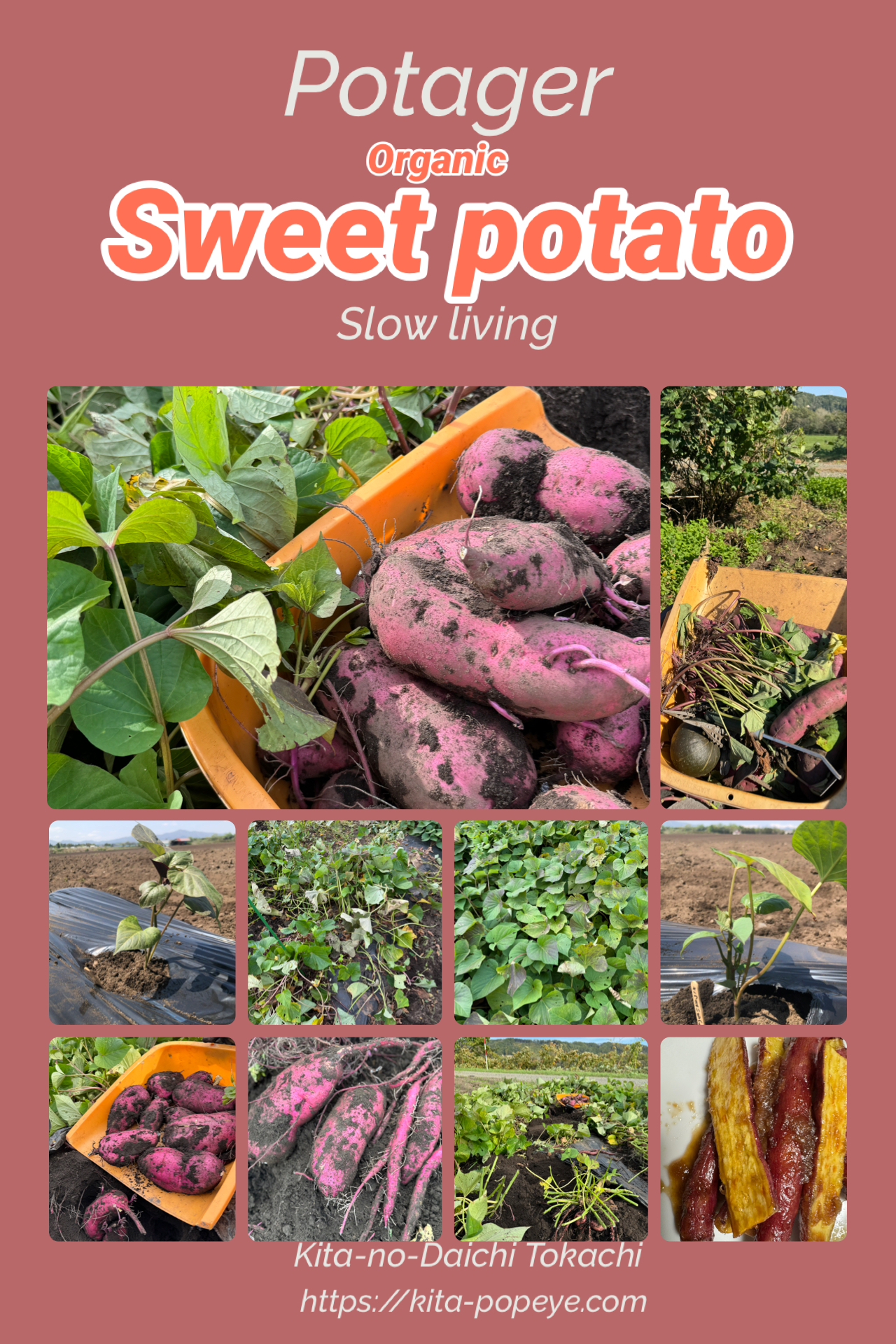



















コメント